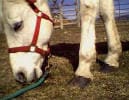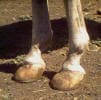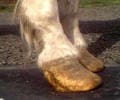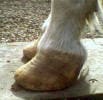



Naturalhorsetrim Listserv Photo
Archives
(Click on thumbnail photos to see larger version.)
Flurry
Feb. 2002...July 2002...March 2003...March 2003
Hinds...hinds done
LF...LF done...LF March 2003
LH...LH Mar. 27, 2003
RF Mar. 27, 2003...RH Mar. 27, 2003...RH
April 7, 2003--fore, and left fore
Flurry's story
We saw all kinds of horses. From the beautiful leopard Appaloosa to the unfortunate horse with the broken knee. Some were saddled and sweating, waiting impatiently for what was to come. Still others were quite possibly drugged with droopy eyes and full body sweating, this being February and still relatively cold. A noticeably foundered Quarter horse mare got all the attention - a group of onlookers thought she was quite something to look at - until she tried to hobble up to them for a closer look. We watched as the youngest of the horses went through the sale first, bringing only $89 to $120 dollars. And the oldest going for slightly more or less - depending... My friend and I kept meandering looking for "Mr. Right" for me. She saw a white gelding and pointed him out. I watched his rider and his reactions as she directed him through the paved aisle and the people horse shopping. I liked his calmness and he wasn't sweating or complaining in the least. I mentioned to Peggy to look at his feet--what was going on there? We made our way to see more of the horses and back again past him this time to our surprise he nickered at us and sought our attention. We are such softies, I thought to myself... We took some numbers of the horses we liked and went to watch the auction. Then a crazed feeling came over me as I saw that white horse with his rider and how even though now he did look sore in his feet, he was very tolerant toward his rider and everything going on. This was the best option for a lesson horse, I thought, and excitedly put everything I had in my pocket into my bid for him. We will see to whatever it is that is wrong with his feet.
It was 2 a.m. the next morning when we arrived home with my new project. We noticed some stiffness as he unloaded from the trailer, and home was only an hour or so from the auction. The next morning I called my vet to report that I had a new gelding that was standing camped out in the typical foundered position. I had hoped to get her out that day, but she said she'd be out my way on Monday. So Monday came and so did our diagnosis - Chronic laminitis, she said, and to bute him 2 grams 2x per day, no grass and very little movement, as that may cause "further damage." So I did the bute. What I didn't do was restrict his movement. Something in me said keep him moving as much as he will allow for himself to move, so I hand walked him whenever I thought about it--2 or 3 times per day.
I reported his status to the vet 2 weeks later and said I'm low on bute, and needed more, but could only get a little at a time, and that he was still noticeably in pain, but walking somewhat better. My answer from the other end was to bute him or put him down. Well, thank you...click. Infuriated, I later found myself online searching for anything to do with founder. Later that week I also found myself unemployed due to layoffs, so now I had the time to do research...
I still had no real name for him, and this particular morning it began to snow flurries. What a perfect name for a snow white horse! I had found something online about overfeeding protein, and how circulation was absolutely necessary to healing the foundered foot. And to keep the horse moving with a boss horse or 15 minutes or so twice a day of hand walking. I had also seen something about the benefits of MSM for foundered horses. My new vet later said that MSM is sulfur, which helps hoof growth, so I added this and glucosamine to his cob, as I found he was a hard keeper.
Later in the week Peggy called with news she had found the old owners. They said he was kept in a concrete pen and fed alfalfa hay, and that his daughter wanted him for barrel racing. They had kept him on bute because he was foundered, and the Dad had shod the horse himself...they had apparently bought him from another sale earlier in the year and now wanted to dump him. Such a wonderful and kind horse he is...to be treated this way! Late in March I started working again, only, at home training a few client's horses.
My farrier would come and reset Flurry and tell me what was going on--that we needed to lower the heels and keep the toe long like it was for just awhile. As is typical for good farriers, he was busy and could only get out every 8 weeks or so, sometimes sooner. Months went by with little improvement. It was now getting to be summer. Each time Flurry was trimmed was agonizing. My farrier is a big guy, and my 15.3 hand Flurry would lean on him and groan. His feet were so pink, purple and bloody showing every bruise and abscess there ever was that I could barely look without crying. My farrier would mention at times that I should have blood work done to see if he's got Cushings or is hypothyroid. Something was definitely causing re-founder here. He said a normal pain cycle for founder is usually about 12 weeks. We were into week 16, and still seeing incredible bruising and separated laminae. His feet were like mush under the shoes.
Then in July I let Flurry out with a boss horse to see if I could hand walk him less to give me more time to work. To my surprise, he soaked his shoes off in the creek! Excited I called my farrier, Jim and told him the news. I said, yes, let's try keeping him barefoot! At this point I had let a 10 year old girl ride him at a walk briefly once a week. And to my surprise he always felt better the next day. There were also black spots on his hairline the next day. He had started blowing abscesses out the coronary band and was beginning the healing process. My farrier and I knew he was rotated in both fronts and that he had foundered on all four feet, due to the black spot at the apex of the frog where the coffin bone had tried to rotate out of the hoof capsule. So I decided that x rays were not entirely necessary. The hairline and hoof wall will tell you that the coffin bone is rotated, just not the degree of rotation. I just wanted him feeling better...and he was.
In September I got some video of him playing in the field with his boss horse...such beautiful movement he had! But it was short-lived, as winter was coming, and his feet started hurting, I'm assuming from the cold and concurrent lack of circulation. I told myself that I would break down and put him in a stall with straw only if it got below 25 degrees out. And he'd only have the stall overnight to help keep his feet warm. It worked, as he would walk very well out of the stall the next morning, and seemed to feel better those days. When it wasn't quite so cold, I kept him out with a boss horse to keep him going. If I noticed he hadn't moved much in a few hours, again, I would go out and hand walk him for as long as we both could stand it.
It was now the end of February, again. Flurry had been with us a year. I went out to see him and nearly started crying, as I had hoped we had gotten further in his recovery. I had found some old photos of his feet in July of last year, and they are too similar to what they looked like now. My farrier didn't come regularly during the winter, as our ground gets so hard and bruises sound horses' feet easily. His feet looked out of control, and I felt overwhelmed as I thought he was still in pain, because he was gimping on his right front.
I had come to the conclusion that I had to make a difference - today. No more waiting for the farrier. I had trimmed my own sound horses before, but never had I seen anything like Flurry's feet. I was relying on my friends and what I had learned online and mostly conventional methods to help him regain soundness. I told Flurry that one way or another he would be out of pain, that I couldn't bear to watch him anymore. So that blustery day in March I picked up my nippers, rasp and hoof knife, and did what I could from what I had learned online and what I knew to be true. I took only his heels down on his hind feet at first because he wouldn't pick up a front long enough for me to trim on it. I was exhausted, but happy that while I hand walked him after the trim I noticed he was no longer gimping so badly!
The next day it was easier to pick up a front foot so I am able to trim on both fronts! This goes on every other day, as I have to trim sole out because his foot is decompressing now. On top of being foundered, he had overgrown sole and bars crushing into sole. In May I had a UH hoof groom, Diana Jones, visit and trim Flurry's feet, and give me pointers on where I need improvement. Currently I trim his feet 2 times per week. His heels are nearly down to where they should be and his toes are well backed up. His left front is starting de-contraction now, and there are no black spots at the apex of his frog. There is also concavity to all four feet.
In the time since I started trimming him in March, to one week later I started riding him once a week (in a straight line!) , then two weeks later twice a week, three weeks later 3 times per week. Six weeks later I was able to ride him at a walk, trot and canter three times a week, and take him trail riding once a week, with no soreness in his feet except an occasional blown abscess. I should mention here that he still has a long ways to go, and that I cannot and will not be schooling him in circles, as his heels are still mostly contracted. But that he is very rideable as a trail horse, and loves it!
Photos are posted here from February of last year to April of 2003. Email me lorrie@elltel.net as I would love to meet anyone with a foundered horse and share the recovery process. I did most of my research online, and talked to vets about whether they felt he had Cushings or Hypothyroid. Flurry shows no outward signs of either. But he did show signs of mineral imbalance, as he didn't sweat on his neck for a year (or more). I gave him 2-3 ounces of Purina12/12 loose mineralized salt in his grain for 6 months. From March of last year to now he has been on grass / Timothy hay and free choice pasture - which was daily regrowth at first. His is a classic case of mechanical founder and ignorance...
Back to
Naturalhorsetrim list photo archives
Back to Treating Founder
without Horseshoes Homepage
Copyright by Gretchen Fathauer, 2013 All rights reserved.